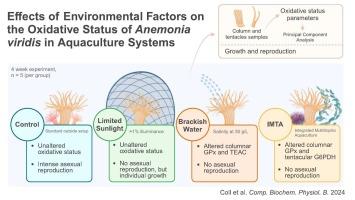环境因素对水产养殖系统中鳗鲡氧化状态的影响。
IF 1.8
3区 生物学
Q4 BIOCHEMISTRY & MOLECULAR BIOLOGY
Comparative Biochemistry and Physiology B-Biochemistry & Molecular Biology
Pub Date : 2024-10-28
DOI:10.1016/j.cbpb.2024.111042
引用次数: 0
摘要
由于刺胞动物 Anemonia viridis 在自然环境中的枯竭,其水产养殖潜力目前正引起研究兴趣。要确保水产养殖的最佳发展和福祉,就必须了解该物种的生理学。本研究测试了不同的非生物条件(有限的阳光、咸水)和生物条件(综合多营养水产养殖或 IMTA)对人工饲养的 viridis 的影响。测量了触手和柱状组织的生长和繁殖情况,并通过抗氧化酶活性(超氧化物歧化酶、过氧化氢酶、谷胱甘肽过氧化物酶、谷胱甘肽还原酶、6-磷酸葡萄糖脱氢酶、谷胱甘肽 S-转移酶和 DT-二磷酸酶)、曲洛毒素当量抗氧化能力(TEAC)和组织脂质过氧化物(MDA)评估了抗氧化状态。与对照海葵相比,咸水和 IMTA 处理中的动物在谷胱甘肽过氧化物酶、葡萄糖-6-磷酸脱氢酶和 TEAC 方面显示出显著变化,这些影响主要出现在柱状组织中。这些结果表明,在渗透干扰或生态交互作用下,涉及谷胱甘肽的酶通路与抗氧化机制有关。有限的光照强度并没有对海葵的氧化状态产生不利影响,尽管维氏海葵有光合共生体。脂质过氧化在任何实验条件下都没有受到明显影响。主成分分析(PCA)表明,类似的抗氧化状态参数与 MDA 浓度呈正相关(触角参数)或负相关(柱状参数)。总之,在适当的环境条件下,通过评估基于抗氧化剂状态的福利指标,可以改善金眼鲷的水产养殖。本文章由计算机程序翻译,如有差异,请以英文原文为准。

Effects of environmental factors on the oxidative status of Anemonia viridis in aquaculture systems
Due to its depletion in natural settings, the potential for aquaculture of the cnidarian Anemonia viridis is currently attracting research interest. Knowledge about the physiology of this species is necessary to ensure optimal development of, and well-being in, aquaculture. This study tested the effects of different abiotic (limited sunlight, brackish water) and biotic (integrated multitrophic aquaculture or IMTA) conditions on A. viridis in captivity. Growth and reproduction were measured, and antioxidant status was evaluated in tentacular and columnar tissues as antioxidant enzymatic activity (superoxide dismutase, catalase, glutathione peroxidase, glutathione reductase, glucose 6-phosphate dehydrogenase, glutathione S-transferase and DT-diaphorase), Trolox-equivalent antioxidant capacity (TEAC) and tissue lipid peroxidation (MDA). Animals in the brackish water and IMTA treatments displayed significant changes in glutathione peroxidase, glucose 6-phospate dehydrogenase and TEAC compared to control anemones, with these effects noted primarily in columnar tissue. These results support the relevance of enzymatic pathways involving glutathione as antioxidant mechanisms under osmotic disturbances or ecological interactions. Limited light intensity was not found to be detrimental to the oxidative status of the anemones, despite A. viridis harbouring photosynthetic symbionts, and enhanced growth performance parameters suggested a higher individual weight increase than in control conditions. Lipid peroxidation was not significantly affected in any experimental condition. Principal Component Analysis (PCA) suggested that similar antioxidant status parameters can correlate positively (tentacular parameters) or negatively (columnar parameters) with MDA concentration. In conclusion, aquaculture of Anemonia viridis can be improved under suitable environmental conditions supported by the evaluation of welfare markers based on antioxidant status.
求助全文
通过发布文献求助,成功后即可免费获取论文全文。
去求助
来源期刊
CiteScore
4.60
自引率
4.50%
发文量
77
审稿时长
22 days
期刊介绍:
Comparative Biochemistry & Physiology (CBP) publishes papers in comparative, environmental and evolutionary physiology.
Part B: Biochemical and Molecular Biology (CBPB), focuses on biochemical physiology, primarily bioenergetics/energy metabolism, cell biology, cellular stress responses, enzymology, intermediary metabolism, macromolecular structure and function, gene regulation, evolutionary genetics. Most studies focus on biochemical or molecular analyses that have clear ramifications for physiological processes.

 求助内容:
求助内容: 应助结果提醒方式:
应助结果提醒方式:


